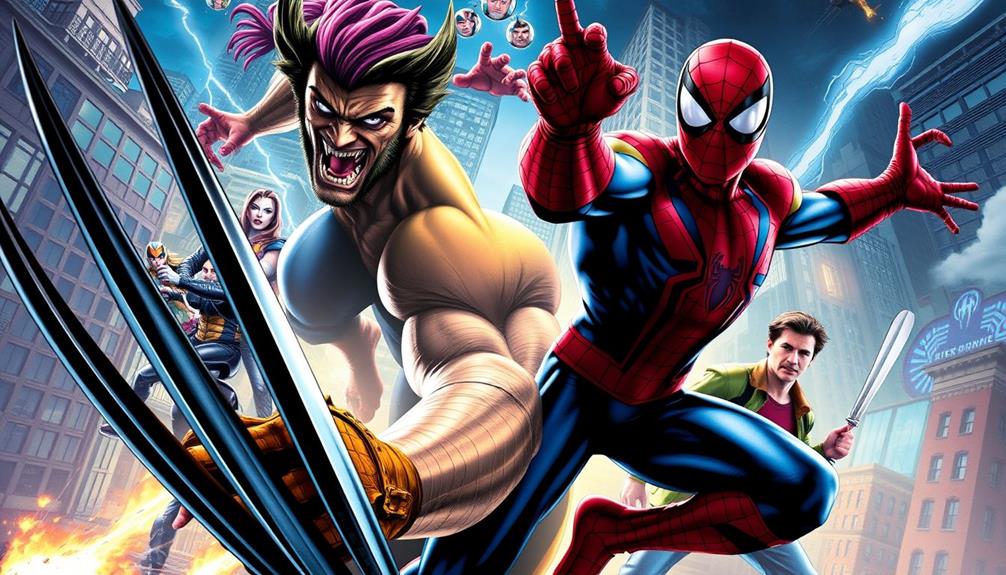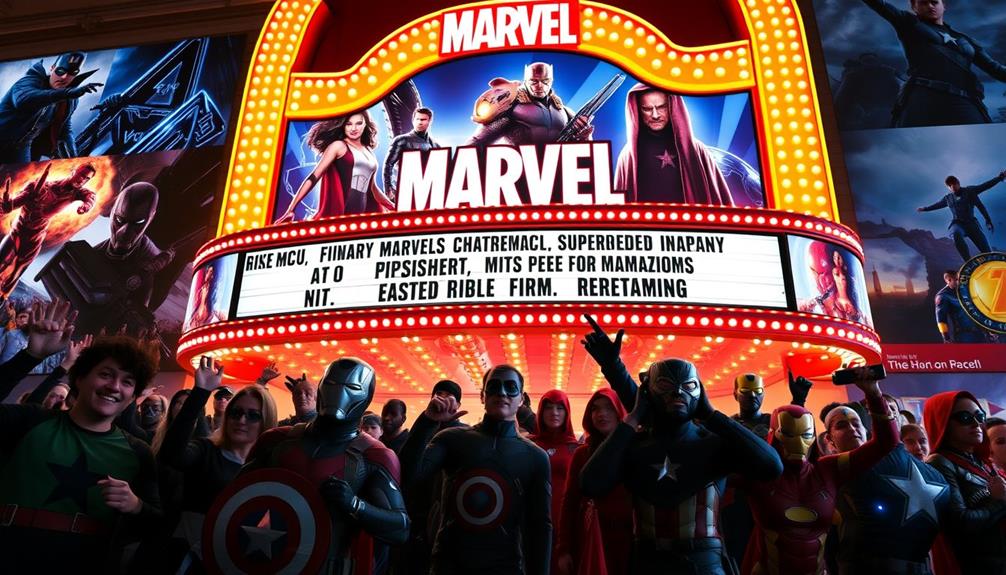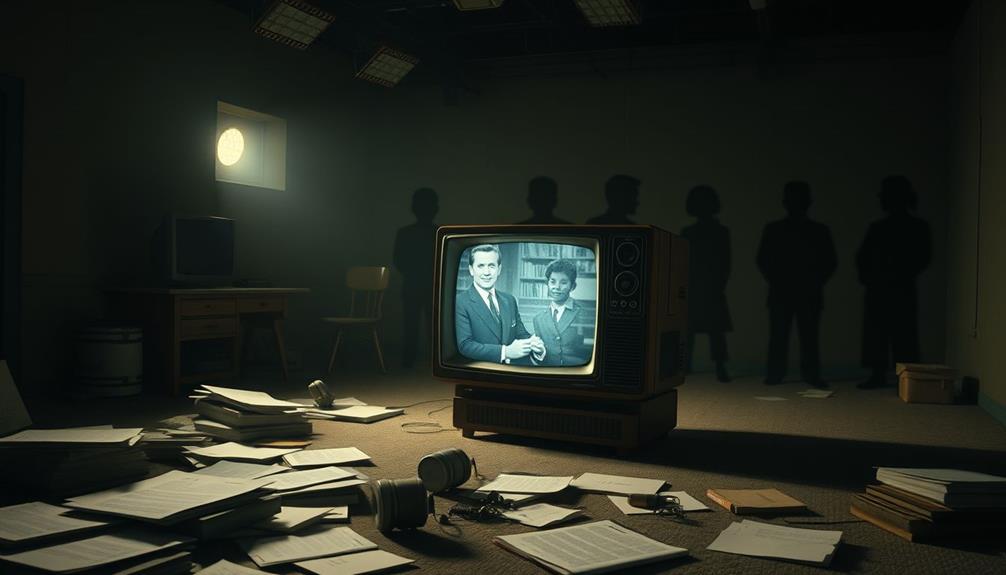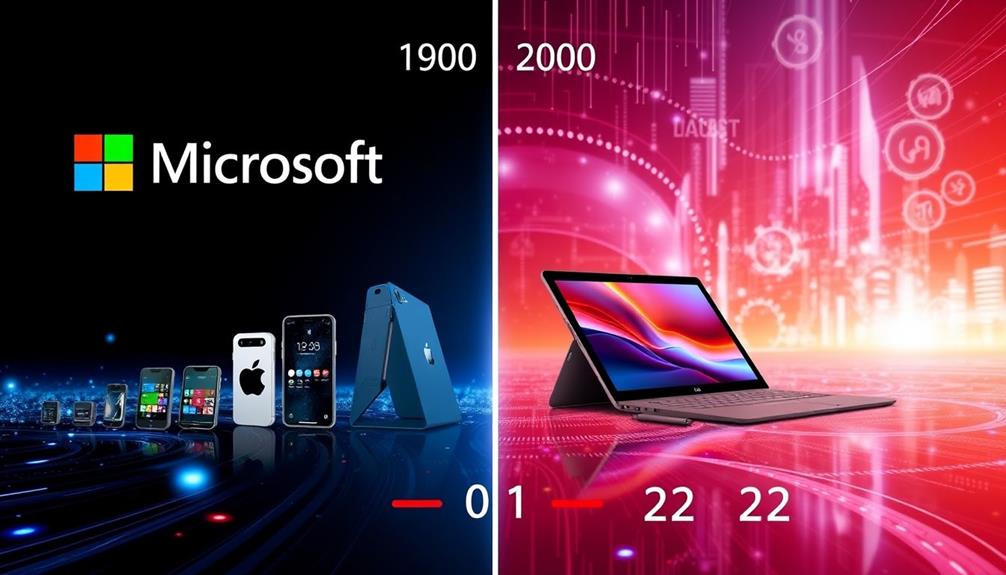Superhero movies have undergone remarkable changes, starting with the game-changing *Superman: The Movie* in 1978. It set a new standard, leading to Tim Burton's darker vision for *Batman* in 1989. The early 2000s brought *X-Men* and *Spider-Man*, emphasizing grounded stories and emotional depth. Then came the MCU, launching with *Iron Man* in 2008, creating an interconnected cinematic universe that's reshaped the genre and culture. Today, we're witnessing diverse narratives and cutting-edge technology enhancing these films. If you explore further, you'll uncover more about how these elements are shaping the future of superhero cinema.
Key Takeaways
- *Superman: The Movie* (1978) set the standard for superhero storytelling and special effects, marking the genre's cinematic birth.
- Tim Burton's *Batman* (1989) introduced a darker tone, emphasizing character depth and emotional resonance in superhero narratives.
- The success of *X-Men* (2000) and *Spider-Man* (2002) shifted focus to character-driven stories and moral dilemmas, influencing the Marvel Cinematic Universe (MCU).
- The MCU, starting with *Iron Man* (2008), established an interconnected universe, generating over $29 billion and redefining shared storytelling in cinema.
- Diverse narratives in superhero films have increased representation, with successes like *Black Panther* and *Wonder Woman* highlighting the demand for varied identities and stories.
Birth of the Genre
The superhero genre burst onto the cinematic scene with the release of *Superman: The Movie* in 1978, revolutionizing how audiences viewed comic book characters. With Christopher Reeve's iconic portrayal of Superman, the film set new standards for storytelling and special effects, paving the way for future superhero adaptations.
Before this, early films like *Adventures of Captain Marvel* and *Captain America* had struggled under technological constraints, primarily appealing to comic book readers. The success of *Superman* not only inspired a wave of superhero films but also highlighted the potential for emotional depth, similar to the heartfelt stories found in best animated movies.
The late 1970s and early 1980s marked a turning point, as the genre changed from serials to major cinematic releases. This shift allowed for more substantial budgets and ambitious projects.
Tim Burton's *Batman* in 1989 introduced a darker and more realistic aesthetic, influencing the visual and thematic direction of superhero films. It showcased how the superhero genre could evolve, balancing action, drama, and complexity.
These early milestones laid the groundwork for the evolution of superhero movies, demonstrating that they could transcend their comic book origins. As you look back, you can see how these foundational films shaped the landscape, setting the stage for the diverse range of superhero narratives we enjoy today.
The Batman Renaissance

With the success of Tim Burton's *Batman* in 1989, a significant shift occurred in the superhero genre, marking the beginning of what fans now call the Batman Renaissance. This film revitalized the genre by introducing darker themes and complex storytelling that appealed to both adult and younger audiences.
You might remember Michael Keaton's portrayal of Batman, which set a new standard for superhero characters. Keaton expertly blended charisma with a brooding intensity, influencing how future iterations of Batman would be shaped. The emphasis on character depth and thematic richness in these films echoes the importance of setting goals in music school, as both require a strong foundation to build upon essential tools for creating music tracks.
Burton's *Batman* was a critical success, grossing over $400 million worldwide, paving the way for sequels like *Batman Returns* in 1992. These films continued to explore character complexities, deepening the narrative and enhancing audience expectations.
The Batman Renaissance transformed how superhero stories were told, emphasizing character depth and thematic richness.
As you watch these films, consider how they laid the groundwork for future superhero movies, inspiring a shift toward richer narratives and darker tones. This period marked a pivotal moment, steering the genre into uncharted territory and setting a template that still resonates today.
Rise of X-Men and Spider-Man

Amidst the cinematic landscape of the early 2000s, Bryan Singer's *X-Men* burst onto the scene in 2000, reinvigorating the superhero genre. This film introduced a grounded approach to storytelling that resonated with audiences, addressing themes of discrimination and acceptance, much like the personal growth emphasized in July 2025 Horoscope Predictions.
Following closely, Sam Raimi's *Spider-Man* hit theaters in 2002, becoming a cultural phenomenon and grossing over $800 million worldwide. Both *X-Men* and *Spider-Man* shifted the focus of superhero films from mere action to character-driven stories, featuring complex characters grappling with emotional arcs and moral dilemmas.
You witnessed how these films laid the groundwork for a new era in superhero cinema. The success of *X-Men* and *Spider-Man* proved that audiences craved depth and relatability in their heroes. As they explored personal struggles and ethical choices, they set a precedent for future adaptations.
This revival of superhero films not only elevated the genre's popularity but also paved the way for interconnected storytelling, which would later define the Marvel Cinematic Universe. You can see how this period marked a significant turning point, establishing a blueprint for what superhero films could achieve beyond simple spectacle.
Launch of the MCU

The launch of the MCU brought several key innovations to the genre, similar to how celebrity relationships evolve and adapt over time, as seen with Jennifer Aniston and Brad Pitt's friendship.
A groundbreaking shift in the superhero genre occurred when the Marvel Cinematic Universe (MCU) launched with *Iron Man* in 2008. Starring Robert Downey Jr. as Tony Stark, the film not only marked the start of an interconnected universe but also achieved critical success, grossing over $585 million worldwide. This was just the beginning of the MCU's ambitious vision for superhero films.
The launch of the MCU brought several key innovations to the genre:
- Interconnected Universe: Characters from different films began to crossover, creating a rich tapestry of storytelling.
- Cultural Phenomenon: The MCU quickly became more than just a series of movies; it turned into a cultural phenomenon that resonated with audiences globally.
- Box Office Dominance: Following *Iron Man*, the MCU expanded rapidly, producing over 32 films and generating over $29 billion globally by 2023.
With major ensemble films like *The Avengers* (2012), the potential of interconnected storytelling was fully realized, setting a new standard for superhero films and enthralling fans around the world.
The MCU redefined what it means to create a shared universe in cinema.
Impact of Shared Universes

Shared universes have transformed how you experience superhero stories by creating narrative interconnectivity that deepens your engagement.
This innovative approach mirrors how reviving old friendships can strengthen connections through shared experiences.
With expanded character arcs, you can see your favorite heroes evolve across multiple films, making their journeys more impactful.
This interconnected storytelling not only heightens anticipation but also enriches the overall cinematic experience.
Narrative Interconnectivity
The rise of interconnected storytelling in superhero films has transformed the cinematic landscape, enchanting audiences like never before. You've likely experienced the thrill of seeing characters from different films interact, a concept popularized by the Marvel Cinematic Universe (MCU) since *Iron Man* launched in 2008.
This shared universe approach not only heightens viewer engagement but also creates a sense of anticipation for sequels and ensemble films. By employing techniques similar to those used in assessing individual traits and behaviors, filmmakers have developed characters that resonate on a personal level with audiences.
Here are three key impacts of narrative interconnectivity:
- Enhanced Audience Engagement: Viewers become invested in character-driven stories, enthusiastically awaiting crossover events and plot developments.
- Inspiration for Other Franchises: The success of the MCU has encouraged the DC Extended Universe (DCEU) and other franchises to adopt similar narrative structures, though results have varied.
- Cultural Impact: Interconnected storytelling has transcended the superhero genre, influencing other film genres and leading to expanded cinematic universes across various franchises.
The film industry has witnessed a paradigm shift, with superhero movies now relying on complex narrative structures and ensemble casts that resonate deeply with audiences worldwide.
Expanded Character Arcs
Through the lens of interconnected storytelling, superhero films have expanded character arcs in ways that captivate audiences. The Marvel Cinematic Universe (MCU) exemplifies this evolution, allowing characters to cross over and enrich one another's narratives. This shared universe model fosters complex character arcs that develop over multiple films. For instance, Tony Stark's transformation from *Iron Man* to his poignant farewell in *Avengers: Endgame* showcases deep character progression.
DC's attempts at shared universes, while ambitious, faced execution challenges. Nonetheless, they aimed to deepen character development through collective storytelling. Theming sacrifice and redemption resonates strongly within the MCU, particularly seen in Thor's journey.
The future looks promising, with upcoming projects like *Doctor Strange in the Multiverse of Madness* poised to explore alternate realities and further enrich established characters. Here's a visual representation of these ideas:
| Key Elements | MCU Examples | DC Attempts |
|---|---|---|
| Expanded Character Arcs | Tony Stark's journey | Superman's struggles |
| Interconnected Storytelling | *Avengers* ensemble | *Justice League* |
| Theming Sacrifice | Thor's arc | Batman's moral dilemmas |
| Upcoming Projects | Future phases of MCU | Potential new DC narratives |
| Character Progression | Natasha's evolution | Wonder Woman's development |
Diversity in Superhero Films

Diversity in superhero films has taken center stage, reflecting a growing recognition of the importance of representation in storytelling.
You've likely noticed how films like *Black Panther* and *Wonder Woman* have made significant impacts, showcasing diverse identities and narratives that resonate with wider audiences.
As the demand for inclusive narratives continues to grow, similar to the rise of vegan food options in mainstream culture, superhero films are beginning to embrace a broader spectrum of characters and stories.
Here are three key examples of this shift toward inclusivity:
- Cultural Representation: *Black Panther* (2018) not only celebrated African culture but also featured a largely Black cast, which was a groundbreaking achievement in the superhero genre.
- Female Leads: With *Wonder Woman* (2017), we saw the first female-led superhero film, highlighting the demand for strong female protagonists in a traditionally male-dominated genre.
- Upcoming Projects: Upcoming projects like *The Eternals* promise to expand on diverse narratives, introducing a range of characters from various backgrounds, which indicates a commitment to representation in future superhero films.
As we move forward, the inclusion of diverse stories and characters, such as strong female leads and Asian representation, will continue to shape the landscape of superhero films, ensuring that everyone sees themselves in these heroic tales.
Technological Advancements in Filmmaking

You can't ignore how CGI and visual effects have transformed superhero movies, making action sequences more thrilling than ever.
The integration of AI-generated music into soundtracks also enhances the overall cinematic experience, providing unique auditory elements that complement the visual storytelling.
Innovative filmmaking techniques, like motion capture, bring characters to life in ways that feel incredibly real.
As technology continues to advance, the future of superhero films looks even more promising with possibilities like virtual and augmented reality on the horizon.
CGI and Visual Effects
CGI and visual effects have transformed superhero movies into breathtaking spectacles that enthrall audiences like never before. These technological advancements have redefined superhero filmmaking, allowing for the creation of stunning visuals that enhance storytelling and audience engagement.
Here's how CGI and visual effects have reshaped the genre:
- Realistic Superpowers: CGI enables filmmakers to portray superpowers and fantastical worlds convincingly, pushing the boundaries of imagination. The use of AI-driven solutions in visual effects allows for more seamless integration of characters into their environments.
- Complex Action Sequences: Major advancements in visual effects technology allow for large-scale battles and intricate action scenes, as seen in films like *Avengers: Endgame* and *Spider-Man: No Way Home*.
- Immersive Experience: The combination of CGI with practical effects, like in *Black Panther*, creates an immersive experience that brings fictional settings, such as Wakanda, to life.
Moreover, innovations in animation and motion capture, showcased in *Spider-Man: Into the Spider-Verse*, have opened new avenues for storytelling.
As visual effects technology continues to evolve, we can expect even more thrilling adventures that further engage audiences, making superhero movies an enthralling experience for everyone.
Innovative Filmmaking Techniques
Innovative filmmaking techniques have greatly changed how superhero stories are told on screen, enchanting audiences with their creativity and realism. The integration of CGI has revolutionized visual storytelling, enabling filmmakers to depict larger-than-life action sequences and portray superheroes with astounding realism.
In movies like *Avengers: Endgame*, advanced special effects seamlessly blend live-action with CGI, creating breathtaking cosmic landscapes that captivate your imagination. Moreover, much like how AI enhances accuracy in medical diagnoses, filmmakers are continuously finding new ways to refine their processes, leading to more immersive cinematic experiences.
Cinematography innovations, such as IMAX technology seen in *Batman Begins*, enhance visual depth, making you feel like part of the action. These techniques elevate audience engagement by immersing you in intricate battles and dynamic lighting effects.
The combination of CGI and practical effects results in immersive experiences that draw you into the narrative. As superhero films continue to evolve, expect even more thrilling adventures fueled by technological advancements.
Filmmakers are set to leverage animation and visual effects to craft innovative narrative techniques that push boundaries. With each new release, you'll find yourself more engaged than ever, witnessing the incredible possibilities that arise from these groundbreaking filmmaking methods.
Cultural Phenomenon of Superhero Movies

Enthralling audiences around the globe, superhero movies have evolved into a cultural phenomenon that reshapes how we engage with storytelling and entertainment. The Marvel Cinematic Universe (MCU) alone has generated over $29 billion, showcasing the genre's impact on cinema with epic blockbusters like *Avengers: Endgame* and *Spider-Man: No Way Home*.
This phenomenon is marked by several key aspects:
- Themes of Heroism: Superhero films highlight teamwork and perseverance, resonating with global audiences and influencing everyday media consumption.
- Merchandising Opportunities: The genre creates extensive product lines, affecting fashion trends and popular culture, proving that superhero movies are more than just films.
- Diverse Hollywood Films: The superhero genre has seen a 17.8% increase in diverse narratives since 2011, reflecting a broader range of comic book characters and stories that appeal to varied audiences.
As superhero movies continue to thrive, they inspire not just cinema, but also comic books, animated series, and video games, solidifying their place as a multifaceted force in entertainment.
Future Directions for the Genre

As you look ahead, the superhero genre is set to embrace more diverse narratives that reflect a wider array of cultures and experiences.
You'll also see filmmakers leveraging new technologies to create innovative storytelling techniques that push the boundaries of the genre.
This evolution promises to keep superhero films fresh and engaging for years to come.
Expanding Diverse Narratives
There's no denying that the superhero genre is on a transformative path, embracing diverse narratives that resonate with a wider audience. Films like *Black Panther* and *Wonder Woman* have set the stage for an inclusive future, showcasing leads from different racial and gender backgrounds. This shift reflects society's demand for representation and the genre's evolving identity.
Here are three key directions for expanding diverse narratives:
- Complex Character Arcs: Filmmakers are crafting superheroes with depth, allowing audiences to connect with their struggles and triumphs, making the stories more relatable.
- Real-World Issues: Upcoming projects like *Shang-Chi and the Legend of the Ten Rings* and *The Eternals* promise to tackle relevant societal themes, integrating cultural narratives that reflect the world we live in.
- Female-Led Superhero Films: The success of titles like *Captain Marvel* highlights the importance of female empowerment, paving the way for more female-led stories that inspire and entertain.
As the superhero genre evolves, you can expect even more diverse narratives, enriching the cinematic landscape and inviting viewers from all walks of life to engage with these powerful stories.
Embracing New Technologies
Superhero films are stepping up their game by embracing new technologies, transforming the way stories are told and experienced. Advanced CGI and visual effects allow you to witness superpowers and epic battles like never before, creating immersive cinematic experiences that captivate audiences. Innovations in technology, such as IMAX cameras and dynamic lighting, elevate storytelling, making you feel more connected to the action on screen.
The rise of motion capture technology has also made animated characters more relatable and nuanced, as seen in *Avengers: Endgame*, where Thanos comes to life with astonishing realism.
As the genre evolves, expect superhero films to incorporate virtual reality (VR) and augmented reality (AR) for interactive experiences. This could redefine how you engage with superhero narratives, making you feel like an active participant in the story.
Additionally, the continuous development of animation techniques, blending 2D and 3D styles, paves the way for unique storytelling opportunities. Projects like *Spider-Man: Into the Spider-Verse* showcase this potential, pushing the boundaries of what superhero films can achieve.
Embracing these technologies will certainly shape the future of the genre and enhance your superhero movie experience.
Independent Filmmaking Opportunities

In recent years, independent filmmakers have tapped into the superhero genre, discovering a wealth of opportunities to showcase their creativity.
With the success of films like *Joker* demonstrating that independent projects can achieve both critical acclaim and commercial success, more filmmakers are enthusiastic to engage.
Here are three ways independent filmmakers are making their mark in this space:
- Film Funding Contests: Initiatives are promoting creative visions and original superhero narratives, providing financial support for new projects.
- Crowdsourcing Funding: Platforms like Kickstarter and Indiegogo enable you to gather resources directly from fans who believe in your unique storytelling.
- Streaming Services: The rise of these platforms allows for broader distribution of independent superhero films, helping diverse storytelling reach wider audiences.
Events like the Sundance Film Festival further underscore the importance of independent films in the superhero genre, as they celebrate innovative work that often challenges traditional narratives.
As an independent filmmaker, you have the chance to shape this evolving landscape and bring fresh perspectives to beloved themes.
Embrace these opportunities!
Conclusion
In this thrilling tapestry of superhero storytelling, you've witnessed the rise, reign, and relentless evolution of caped crusaders. From Superman's soaring beginnings to the Marvel Cinematic Universe's magnificent multiverse, each chapter captivates and connects with fans worldwide. As filmmakers forge fresh frontiers and independent innovators inject new ideas, the future's filled with fantastic possibilities. So, keep your eyes peeled for more heroic happenings—after all, the adventure's just begun, and the sky's the limit!









